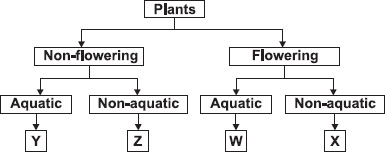Match the following columns and select the correct option.
| Vitamin | Deficiency disease |
| a. Vitamin A | (i) Scurvy |
| b. Vitamin B | (ii) Anaemia |
| c. Vitamin C | (iii) Night blindness |
| d. Vitamin D | (iv) Beri-Beri |
| (v) Rickets |
A a - (v), b - (ii), c - (iii), d - (iv)
B a - (iii), b - (iv), c - (i), d - (v)
C a - (iv), b - (iii), c - (v), d - (ii)
D a - (iii), b - (iv), c - (ii), d - (v)
Ans 12:
Ans 19:
Post Your Answer
Ans 1:
Ans 4:
Post Your Answer
Post Your Answer
Post Your Answer
Ans 2:
Ans 4:
Post Your Answer
Post Your Answer
The following table shows some information on four plants, (A), (B), (C) and (D). A tick (√) indicates that the plant shows that particular characteristic.

Based on the information above, which letter, W, X, Y or Z, best represent plants (C) and (D)?

| Plant (C) | Plant (D) | |
| A | W | X |
| B | X | Y |
| C | Y | Z |
| D | Z | W |
Ans 5: (Master Answer)
The correct answer is A.
Both plants ‘c’ and ‘d’ bear fruits. This means they are flowering plants as only flowers change into fruits. Plant ‘c’ grows in water i.e., it is an aquatic plant but plant ‘d’ does not grow in water thus, it is a nonaquatic plant. Hence 'W' and 'X' represent plant ‘c’ and ‘d’ respectively.
Post Your Answer
Post Your Answer
Ans 7: (Master Answer)
The correct answer is D.
X is oesophagus with no change in amount of undigested food. Y is stomach and Z is small intestine with decreasing amount of undigested food and P is large intestine as no further digestion occurs here.






